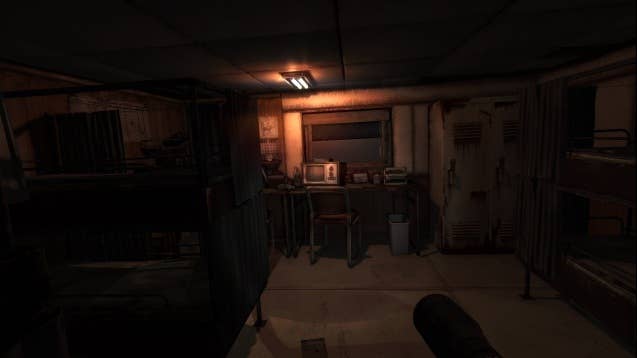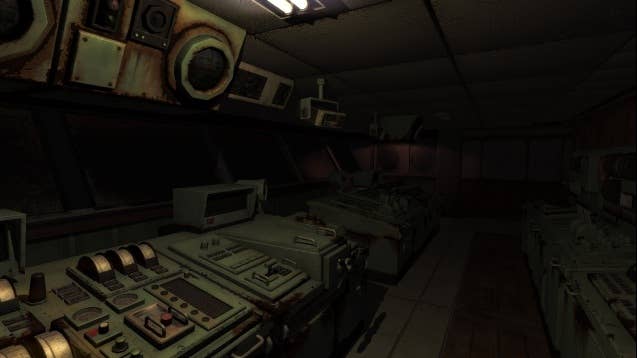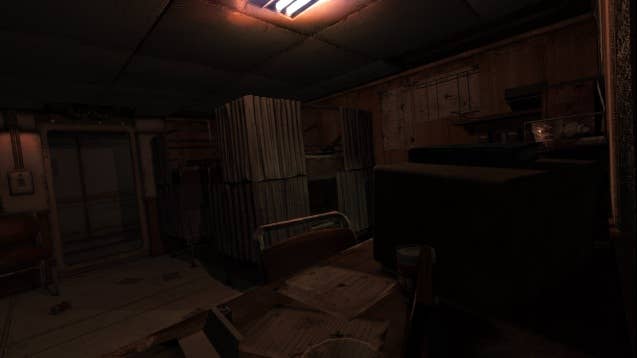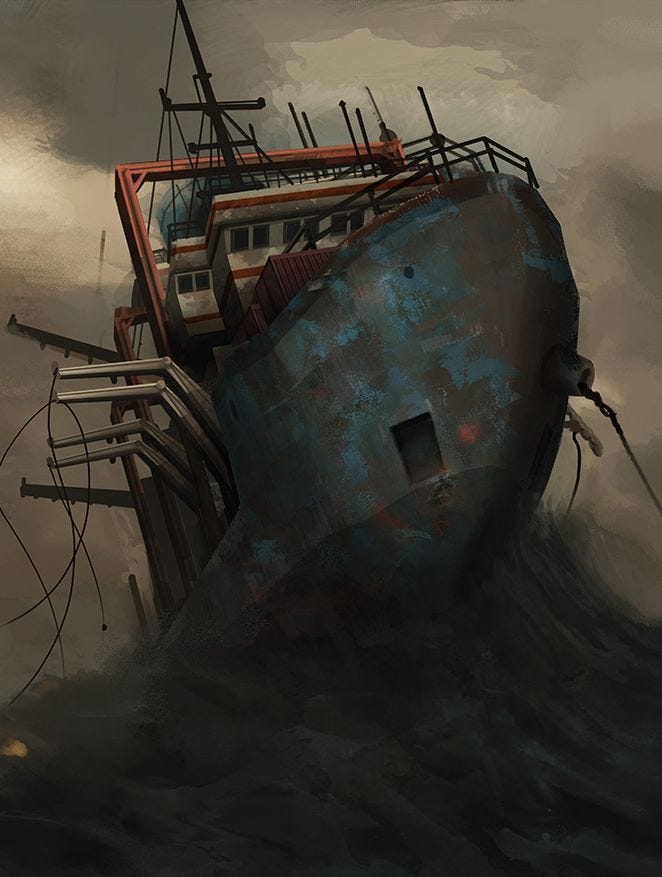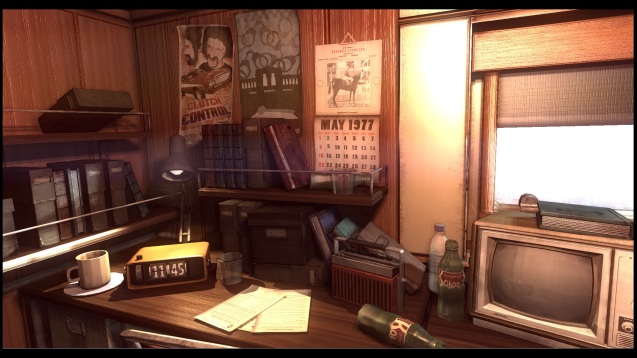Monstrum: procedurally-generated horror on the lost ship from Hell
Monstrum is a new breed of survival horror that uses procedurally-generated elements to ensure each play through is both unpredictable and terrifying. Dave Cook speaks with developer Team Junkfish about its incoming Steam release.
”On paper it sounds like the most demonic game of Pac-Man ever conceived, as your survivor attempts to flee a stranded 1970s sea freighter while being hounded across its maze-like corridors by an unrelenting monster.”
Ambiguity goes hand-in-hand in fear. Say, for example, you watch a scary film for the first time and find yourself caught off-guard by unexpected jumpy moments and disturbing imagery. Will you be as frightened during your second viewing? Probably not.
That's because the horror genre is tied to diminishing returns, and that age-old truth that the more we come to understand something, the less-intimidating it becomes. Speaking with Jaime Cross of Monstrum developer Team Junkfish, I bring up that classic scare at the start of Capcom's original Resident Evil. You probably know the bit I'm talking about, with the dogs that jump through the window?
When I first experienced that section in my youth I was truly scared, largely because I had never seen such a cinematic attempt to frighten players before. It worked, but as the years went by, I memorised precisely when and where those bastard canines were going to attack, and the fear was gone forever. Horror games are prone to this dilution over time, and that's the problem Monstrum's developers are looking to solve.
On paper it sounds like the most demonic game of Pac-Man ever conceived, as your survivor attempts to flee a stranded 1970s sea freighter while being hounded across its maze-like corridors by an unrelenting monster. The beast will never stop searching for you as you try to piece together whatever supplies you need to make good your escape, and to make matters worse, each playthrough sees the ship's interior completely randomised using procedural tech in Unity.
”You’ll never know which of Monstrum’s several creature types have spawned in at the start of the play-through. Given that you have no means to fight back, you’ll need to think about self-preservation constantly.”
"It was a bit weird," Cross recalls. "When we were discussing ideas it was a case of everybody being told, 'come up with an idea,' and the guy that did, Grant, who is one of the programmers said, 'I like Amnesia and I like The Binding of Isaac, let's see if we can smoosh them together and make a replayable horror game.'
"One of the things he mentioned was in Amnesia, if he plays it again he knows where all the scares are going to happen, where the monster's walking patterns are going to be, and so every time he goes through it the effect is reduced. As hesitant as I am to use the term 'more roguelike,' we wanted it so you don't know where the monster is – he could be around the next corner or it could be on the other side of the ship – just to make it a bit more uneasy that way."
The aim in Monstrum isn't simply to find the ship's exit and stroll out to safety. In fact, the final build should throw multiple escape routes at players with randomly-placed sub-objectives that must be fulfilled to proceed. "The room positioning and corridors are all procedurally generated," Cross explains, "but it even goes a little deeper than that.
"Inside the rooms there will be random items scattered on tables and stuff like that, as well as non-consequential items that will be randomly-generated, and things on the walls. Collectibles have spawn points in rooms and they're not so much randomly-placed, but will be generated from a pool of items that way."
”In another sadistic turn, Team Junkfish has created a second monster type that is harder to hear, and won’t give chase once it spots the player, rather, it will seek an alternative, stealthy route towards its prey.”
Cross explains that one escape method is the life raft, which must first be patched up with duct tape, inflated, hooked on to a lowering winch and lowered into the water outside, before the player finds their way down to the dingy and casts off to safety. Doing all of this without any sense of direction, while being hunted by aggressive AI, sounds like a total nightmare.
To make matters worse, you'll never know which of Monstrum's several creature types have spawned in at the start of the play-through. They each have different behavioural AI settings and methods of attack.
Given that you have no means to fight back, you'll need to think about self-preservation constantly. Cross tells me that his testers regularly try to whack the beast with boat oars and other objects with zero effect, but he feels that giving players direct power over the monster would cheapen the scare factor.
Cross explains the decision by saying, "You don't want it just to be 'Oh I've been spotted, I need to go run and hide somewhere,' because that can get quite boring quickly, even if you've got multiple places to hide. We did toy with the idea of trolling people a little bit, so if you found a gun and you tried to use it on the monster, but then you find it's actually a novelty lighter, and all you get is a little flame going out, but we thought that might be a little too evil."
That'd be evil indeed, but I suggest that little easter eggs like that could make for some great YouTube Let's Play fodder, but no, the player's only means of delaying their death is to either distract or trap the monster. "There's a few things that you could potentially do," he goes on, "and things you can do before the monster is chasing you as well.
”Seeing rooms filled with retro decor and movie posters, set against the sound of ’70s music over the radio reminds me of BioShock’s rapture, a place that felt out of sync with its era.”
"You can set up little audio distractions – radios, TVs – and it'll investigate them if it hasn't spotted you, so you can try and lure it away from an area you want to investigate. Beyond that you can set up traps or there might be actual environmental hazards that you might be aware of, that you can try to lure the monster into.
"We've been talking about having parts of the floor come away whenever you or the monster run over it, so that'd be a break in the chase. If you fall through you'll see the monster reach down to try and grab you, and then go off to try and find you again when it realises it can't pass through. We can set up little traps like that as well."
"Just now the traps are more environmental hazards than things you can do," he adds, "but there's things like the floor panels that trip you up when you walk over them - the same thing happens to the monster. In later builds we're hoping to include fire and water hazards, plus some monsters that might be more sensitive to fire, so you might be able to get a fuel can and a lighter, then use them to start a fire hazard, a little flame wall.
"That might not be a good idea if then you can't get through it, because if you set a room on fire you're kind of dead. But then again, if you get a fire extinguisher you might be able to combat it that way, and little things like that."
Interestingly, the monster doesn't simply phase into the world nearby at trigger points, rather, it's always active in the world, sweeping each room and deck in the hopes of spotting you. Being seen results in a chase, and while the player can hide it out until the beast moves its search elsewhere, the savage Brute type is capable of smashing down doors as it gives chase. It's not easily fooled, but it is entirely possible for the player to be standing on one side of the ship, only to hear the monster trigger a trap they placed earlier on the other.
Cross reveals that the team is consider giving players a slight warning that their hunter is nearby, possibly linked to a heat mechanic. He theorises that perhaps the player could cough due to a shift in atmosphere around the beast, alerting the player to its presence. Currently, the AI sign-posting is purely sound based, but in another sadistic turn, Team Junkfish has created a second monster type that is harder to hear, and won't give chase once it spots the player, rather, it will seek an alternative, stealthy route towards its prey.
I close our chat by asking Cross about ambiguity, and to what extent the team is willing to explain why the player is trapped in a ship from the 1970s. Seeing rooms filled with retro decor and movie posters, set against the sound of '70s music over the radio reminds me of BioShock's rapture, a place that felt out of sync with its era. Cross agrees with the comparison and stresses that his team doesn't want to explain everything actively. Instead, collectible notes and other clues will dispense passive clarity with each play-through.
Team Junkfish and Cross really do understand the problem of repeat play in horror games. The way players can cobble together traps in the world or use resources to their advantage reminded me of Dead Space hero and versatile engineer Isaac Clarke, in the way that they will cobble together defences with whatever items they can find.
Cross replies by saying that the first time he played Dead Space, he did so only using the player's default Plasma Cutter weapon because it fit Isaac's role as an engineer. It also put him at a severe disadvantage against the monstrous hordes encountered throughout the game, a challenge I suspect he relished.
Yep, he definitely gets it.
Team Junkfish hopes to release Monstrum on PC this year, and may or may not release some form of early access build this Autumn. We'll update you as things get narrowed down. In the meantime you can check the game out over on Steam Greenlight.

